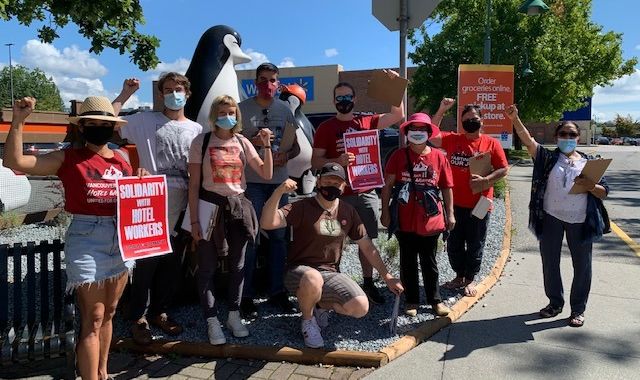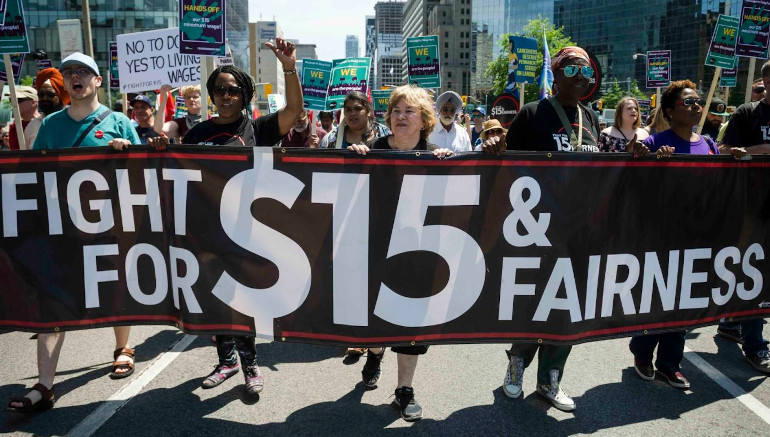Including Growing Second Wave and New Closures
Even now, nine months since reports of COVID-9 emerged Canada still does not have enough PPE or test kits and tracing is weak.
For months, Canadians have been held in the grip of an unprecedented pandemic that has left few people untouched. Canada failed to protect workers and vulnerable Canadians. One of the most egregious examples was the Alberta government’s refusal to shut down Cargill’s meatpacking plant in High River, Alberta despite more than 1,500 cases of coronavirus associated with the plant, and three people who died. This demonstrates both the relentless pursuit of profit by capitalists and the readiness of government to protect business interests, at all costs.
As the virus first hit, Canadians witnessed its murderous rampage among those who are most vulnerable: elders living in care homes. Over 80% of deaths in Canada have been among those living in long-term care. Our revered universal health care system was exposed for what it is: not quite an empty shell but a vessel with many leaks. Health care workers lacked essential of PPE. Only now is Canada arranging for the domestic manufacturer of PPE, rather than having to rely on insecure sources from elsewhere. COVID has laid bare the huge gaps in our social security network: people living on the street; renters who fear being evicted if they can’t pay the rent; people using opioids alone and dying in record numbers; and the uneven burden of COVID on precarious workers, including those in the gig economy, temporary foreign workers, and those working in the hospitality industry and retail.
School reopening
As schools across the country have reopened, the number of COVID cases is steadily climbing, almost everywhere, creating high levels of uncertainty and fear. This is not surprising as the economy, particularly since the end of June, has moved from lockdown mode into various phases of reopening.
The reopening of schools, after months of online learning and a summer break, signals a new phase in how Canadians are dealing with the pandemic. While on the surface, governments recognize the importance of education for children’s development, most are reluctant to pay for the necessary measures, such as smaller class sizes, physical distancing and mask-wearing, to ensure safety for students, teachers and other staff. Governments want to restart the economy. With students at home, many parents have been put in the difficult position of staying home, foregoing both jobs and income, a trend which has hit women the hardest. Capitalism needs children in schools to ensure the economy has a steady supply of workers, and to train the next generation to be wage-earners.
While many, parents and educators alike, believe that reopening schools is needed for the social and educational development of children, they are understandably uneasy about the conditions under which it is happening. Already, in the first week of students returning, multiple cases of COVID are being reported in schools across Canada, causing some schools to temporarily re-close and others to send students home to isolate.
Economic unease
This isn’t the only worry for Canadians. The economy has been in suspended animation for months. While some corporations have made record profits from the pandemic, ordinary people have been hit hard with job loss and reduced work hours, while small businesses have struggled to survive, some unsuccessfully. There are 1.1 million fewer paid workers now than in February, before COVID-19 hit.
Essential workers in grocery stores, who at the outset of the pandemic received “hero” pay, are back to working on pre-COVID wages, with record profits going into the coffers of corporations, which accumulate wealth for their shareholders. While profits soar, many regular people are posed on the edge of a financial precipice.
Inequality has never been greater than it is today. The very richest amass unprecedented levels of wealth. In 2019, the richest 1% owned 44% of the world’s wealth. The world’s 10 richest billionaires own $801 billion in combined wealth, a sum greater than the total goods and services most nations produce on an annual basis. All of this wealth is created on the backs of those who work for wages, many of them low paid workers and in dangerous conditions. Canada’s inequality ranks 12th out of 17 countries.
Climate anxiety
The ongoing climate crisis, combined with government inaction, causes further stress. The astonishing number of record-breaking storms, forest fires, droughts, heat waves, and floods are signs that all is not well with our earthly home. This summer has seen record-breaking temperatures in California and the second biggest fire season ever. These kinds of events have occurred with just1.0 degrees Celsius of global warming. The IPCC’s report in late 2018 predicted 2.7 degrees Fahrenheit could be reached in as little as 11 years and most certainly within 20 years without major cuts in CO2 emissions. Most of us do not want to see what kind of havoc 2.7 degrees of warming will reap.
Taken together, these crises combine into a volatile amalgam of fear, anger, uncertainty, and despair. These crises combine into an existential crisis, particularly for young people, who are faced with the burden of dealing with the consequences of these disasters as well as the responsibility to do something about them.
Politics as usual
It appears that most political parties have not got the message about the depth of these crises, nor Canadians’ concern about them. Even if they have an inkling, they lack the political will to act.
The BC NDP looks likely to call an election this autumn. While, in most cases, they have acted like a responsible liberal-minded government, they failed to adequately deal with the crisis of climate change, forging ahead to build the wasteful Site C dam and continue their commitment to LNG projects, including the Coastal Gas Link Pipeline, despite fierce opposition from the Wet’suwet’en hereditary chiefs. Their hypocrisy around Indigenous self-determination is galling, with their actions belying their lofty words.
The Alberta government is trouncing on the rights of just about everyone in Alberta: teachers, health workers, unions, temporary foreign and immigrant workers; it is determined to do what it can to prop up a failing resource sector and will bring the economy down to unspeakable depths.
Federally, the faces are changing but the politics remain largely the same. The Conservative Party elected Erin O’Toole as their new leader who, like the last leader, is a social conservative who pretends to be progressive on social issues. The Green Party is currently holding a leadership campaign. The Liberals have managed to weather a number of scandals, including the recent WE scandal, and have prorogued parliament until September 23, in an attempt to bring in a new program. There is speculation that they, too, may call an autumn election. The NDP may hold the balance of power, as they have done in the past. However, their characteristic lack of boldness and imagination may hinder real change. This could be a real opportunity for the NDP to push hard for a national pharmacare program, universal daycare, a national affordable housing program and much improved EI benefits for workers, never mind public ownership and a Green New Deal for workers.
Over the last few months Trudeau and most Premiers have had high opinion poll ratings with Canadians showing unity in the face of COVID. However, when the economic realities and a second wave of COVID hits, this could rapidly change.
Movements and Mounting Anger
What will move governments is movement from below. 2019 saw mass protests in Canada and around the world – of young people and women, for climate justice, to end austerity and inequality, and for democracy and racial justice. While COVID paused the protests, the anger remains. COVID pressure-cooked the anger, which erupted in the wave of BLM demonstrations around the world, reaching communities that have not seen protests in decades. Canadians were shocked by the violence and systemic police racism against Indigenous people. This materialized in the BLM rallies held in many communities across Canada this summer. Calls to defund the police and address systemic racism won’t go away soon.
Organized labour is still quiet, although that could change with events. Alberta appears to be the most volatile of provinces and there could be explosive events in the coming months. Unite Here Local 40, representing hotel workers, took a number of actions to put pressure on the BC NDP to ensure the legal rights of laid-off hospitality workers to return to their jobs. However, their push was not successful, and they are re-assessing their strategy.
Whether provoked by the renewed construction around the Trans Mountain Pipeline, increased rental evictions or another egregious act of police violence against Indigenous people or people of colour, there is seething anger below the calm surface of Canadian waters, anger that could erupt into new waves of protest.
At the start of World War I, it was said it would “All be over by Christmas,” yet the slaughter lasted four bloody years. Most leaders act as if these current shocks will also be over in a few short months, but their impact will roll on for years.
In all of this volatile amalgam, what characterizes this period more than anything is uncertainty about the future. While there is some relief at the easing of restrictions, which caused economic hardship and a spike in overdose deaths, increased domestic violence and a wave of mental health problems, there is fear. Many people have a clear sense that the old is dying. What is unknown is what the future holds.
We hold up a vision for a different kind of future, one based on socialist reconstruction, that births a new world of equality, fair distribution of the fruits of the earth and labour and justice for all. Join us!




